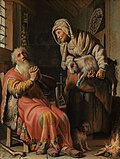Top Qs
Timeline
Chat
Perspective
Anna and the Blind Tobit
Painting by Rembrandt From Wikipedia, the free encyclopedia
Remove ads
Anna and the Blind Tobit, also titled Blind Tobit and his Wife, is a c. 1630 oil painting by the Dutch Golden Age painter Rembrandt, and perhaps his pupil, Gerrit Dou. The picture hangs in room 22 of the National Gallery in London.[1]
Remove ads
Background
The story of Anna, her husband Tobit and their son Tobias is told in the apocryphal Book of Tobit. God tested them by reducing them to poverty and causing Tobit's blindness. In the 17th century they were considered to be examples of piety in adversity. Rembrandt painted a number of episodes from the story, and in this picture he depicts the old couple waiting for the return of their son, Tobias, who has embarked on a long journey to restore his parents' fortunes.[1]
Remove ads
Attribution


This painting was engraved as the work of Rembrandt during his lifetime, but it has subsequently been argued that its meticulous detail suggests that it was either a collaboration between Rembrandt and his Leiden pupil Gerrit Dou, or by Dou alone.[2] Recent comparisons with the work of Rembrandt and Dou have made it clear that the painting is, in fact, an authentic work by Rembrandt painted in about 1630.[2] Some traces of a signature can be seen: "Re[.]bra[…]".
Remove ads
Provenance
- by 1881: John Bell 1 February 1881–5 February 1881: sale of the collection of John Bell at an unknown auction house, Glasgow, lot no. 357 (as [Gerard] Dou);
- Unknown date: acquired by Sir Remy Watson, Braco Castle, Perthshire;
- by 1926: Dennis Elliot Watson, London;
- 1926: purchased by the National Gallery, London.[2]
Related works
- Pieter Lastman: The Angel Raphael Takes Leave of Old Tobit and his Son Tobias, 1618
- Abraham Bloemaert: Landscape with the Exodus of Tobias and the Angel, 1630
- Rembrandt: Tobit and Anna with the Kid, 1626
- Rembrandt: Philosopher in Meditation, 1632
- Rembrandt: Tobias Healing his Blind Father, 1636
- Rembrandt: The Angel Raphael Leaving Tobias' Family, 1637
- Rembrandt and workshop: Tobit and Anna with the Kid, 1645
- Rembrandt: Tobit and his Wife (Tobit and Anna), 1659
Remove ads
See also
References
Sources
Further reading
Wikiwand - on
Seamless Wikipedia browsing. On steroids.
Remove ads









